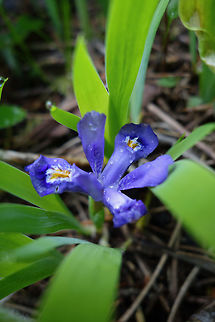
Appearance
It is similar in form to ''Iris cristata'' but is chromosomally different and smaller.It has slender, wiry, or cord-like, greenish-brown, or yellow rhizomes. It has a large central section and outer sections, which are 3–5 cm long and 0.8–1.2 cm wide. The outer sections have fibrous roots , and 2–3 brown scale-like leaves above.
It creeps across the ground, creating thick clumps of plants.
It has 8–12 sheathing, , green or light green, basal leaves. They are falcate or sword-shaped, and linear, and 4–6 cm long and 10–8 mm wide.
After flowering, the leaves elongate up to 15–16 cm long and 10 mm wide.
When the plant is not in flower, the leaves of the iris might be confused with false asphodel, which lives in similar habitats. Although, the flower stem of false asphodel is much longer than that of iris and very sticky.
It has very short stems, which are 0.8–5 cm long. The stems and flowers are shorter than the leaves.
It has green spathes , which are slightly keeled, and 3–4.5 cm long. They have scarious edges.
The short stems have 1 to 2 flowers, in Spring, or summer , in April, or May, or early June, or July.
In Spring, it can flower 7 to 10 days earlier than ''Iris cristata''.
It can have later flush of flowers in the fall , or October.
The flowers are 4–6 cm in diameter, come in shades of blue, violet-blue, sky blue, deep blue, lavender blue, lilac, or deep purple.
A white form has occasionally, also been found.
It has 2 pairs of petals, 3 large sepals , known as the 'falls' and 3 inner, smaller petals , known as the 'standards'.
The obovate, falls are 2–2.3 cm long and 0.8 cm wide. They taper towards the claw . They have a white signal patch, which has a deep violet margin, and 3 central, orange, gold, or yellow and white toothed ridges . The signal patch guides bumblebees in to the middle of the flower, to pollinate it.
The standards are narrowly oblanceolate, 1–1.5 cm long and 0.4–0.5 cm wide. They are shorter and narrower than the falls.
It has a yellow funnel-like, perianth tube, which is 1–2 cm long. The tube is shorter than ''Iris cristata''.
It has a trigonal , ovary, which is 0.8–1 cm long. It has a 1–2 cm long style, which has linear crests and wavy edges.
The style arm guides bumblebees to the lower section of the sepal, to reach the nectar.
After the iris has flowered, between late June to late July, it produces a roundly triangular, or ovoid, seed capsule,
which are covered by the spathes. The capsules are 1.2 mm long and 8 mm wide.
Inside the capsule, are 3 mm wide, dark brown seeds, which have a white appendage , spiralled around the seed.
This spiral or corkscrew-like appendage is called an ''eliaosome''. The eliaosomes are used as energy-rich food sources by ants, who help pollinate the plant.
Distribution
''Iris lacustris'' is native to temperate regions of northern America.Status
''Iris lacustris'' is designated a "vulnerable" threatened species by federal, state and provincial laws throughout its distribution range. It was added to the U.S. List of Endangered and Threatened Wildlife and Plants on September 28, 1988. It is on the U.S. Fish and Wildlife Service's endangered species program. It was listed by the federal U.S. government as 'threatened' since February 1, 2001. It has become threatened due to habitat destruction, from shoreline development, from road-widening projects, chemical spraying and salting, and off-road vehicle use have caused disturbance and destruction of habitat, and degradation of habitats.Due to being a protected species, plants can not be dug up or seeds gathered. A permit is required for any project which may "take" or "harm" threatened or endangered species in Michigan. Also 37% of the Canadian population is on land in protected areas. Shoreline development has also improved some habitats by opening up the canopy and creating new open ground.
Habitat
''Iris lacustris'' is native to temperate regions of northern America.It grows on the Great Lakes shorelines in cool, moist lake shore air.It is found on sand, or in thin soil over limestone-rich gravel, in calcareous soil, or bedrock.
It also grows on alvar limestone barrens.
Along shorelines, old beach ridges, beside streams, in ditches, on cliffs, behind open dunes, or at the edges of coniferous woods .
Defense
Like many other irises, most parts of the plant are poisonous , if mistakenly ingested can cause stomach pains and vomiting. Handling the plant may also cause a skin irritation or an allergic reaction.Cultural
In 1998, ''Iris lacustris'' was designated the state wildflower of Michigan, where the vast majority of populations exist.References:
Some text fragments are auto parsed from Wikipedia.